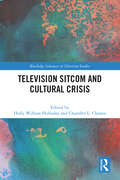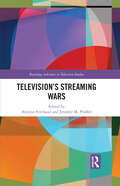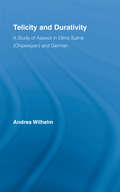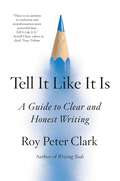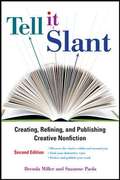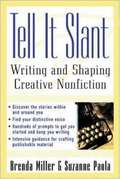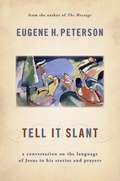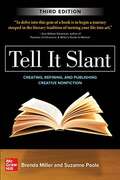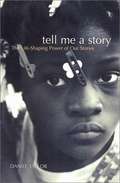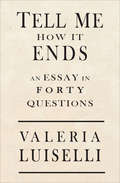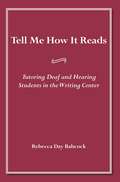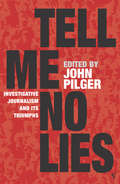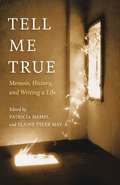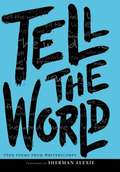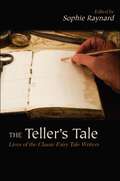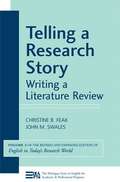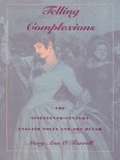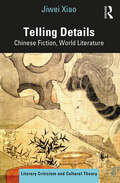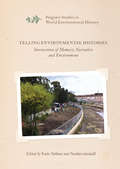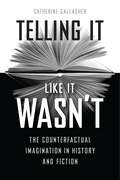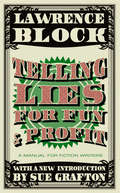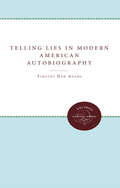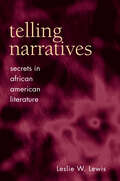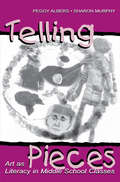- Table View
- List View
Television Sitcom and Cultural Crisis (Routledge Advances in Television Studies)
by Holly Willson Holladay Chandler L. ClassenThis volume demonstrates that television comedies are conduits through which we might resist normative ways of thinking about cultural crises.By drawing on Gramscian notion of crisis and the understanding that crises are overlapping, interconnected, and mutually constitutive, the essays in this collection demonstrate that situation comedies do more than make us laugh; they also help us understand the complexities of our social world’s moments of crisis. Each chapter takes up the televisual representation of a modern cultural crisis in a contemporary sitcom and is grounded in the extensive body of literature that suggests that levity is a powerful mechanism to make sense of and cope with these difficult cultural experiences.Divided into thematic sections that highlight crises of institutions and systems, identity and representation, and speculation and futurism, this book will interest scholars of media and cultural studies, political economy, communication studies, and humor studies.
Television’s Streaming Wars (Routledge Advances in Television Studies)
by Arienne Ferchaud Jennifer M. ProffittThis volume addresses contemporary debates and trends regarding the production and distribution, content, and audience engagement with the television streaming industry. The book interrogates the economics and structure of the industry, questions the types and diversity of content perpetuated on streaming services, and addresses how audiences engage with content from US and global perspectives and within various research paradigms. Chapters address television streaming wars, including the debates and trends in terms of its production and competition, diversity and growth of programming, and audience consumption, focusing on multiple platforms, content, and users. This timely and creative volume will interest students and scholars working in television studies, media industry studies, popular culture studies, audience studies, media psychology, critical cultural studies and media economics.
Telicity and Durativity: A Study of Aspect in Dëne Suliné (Chipewyan) and German (Outstanding Dissertations in Linguistics)
by Andrea Luise WilhelmThis book studies the linguistic representation of events by examining the relevance of two salient event characteristics-- telicity and durativity-- to the grammatical system of natural language. The study of events, and of event characteristics, is an important testing ground for theories on the boundary between extralinguistic and linguistic knowledge, and on the relation between semantics and syntax. Telicity and durativity are notions which have become increasingly influential in both the semantic and the syntactic, i.e., grammaticalized, representation of events. The book furthers the understanding of events through the comparison of two genetically and typologically distinct languages, German and Dëne Suliné (Chipewyan/Athapaskan), an indigenous language of Northwestern Canada. It contains the first in-depth documentation of the aspectual system of Dëne Suliné, and a careful analysis of the aspectual behaviour of German particle verbs. A stringent methodology considers semantic, pragmatic, and grammatical factors in both languages. The data reveal that telicity and durativity belong to profoundly different semantic and grammatical domains, and that neither notion is grammaticalized universally. While both notions are represented semantically in German as well as in Dëne Suliné, telicity is grammaticalized only in the former and durativity is grammaticalized only in the latter.
Tell It Like It Is: A Guide to Clear and Honest Writing
by Roy Peter ClarkAmerica's favorite writing coach and bestselling author returns with an "indispensable" guide (Diana K. Sugg, Pulitzer Prize-winning reporter) to writing clearly and honestly in a world full of lies, propaganda, and misinformation. The darker and more dystopian the future appears, the more influential public writers become. But with so much content vying for our attention, and so much misinformation and propaganda polluting public discourse, how can writers break through the noise to inform an increasingly busy, stressed, and overwhelmed audience? In Tell It Like It Is, bestselling author, writing coach, and teacher Roy Peter Clark offers a succinct and practical guide to writing with clarity, honesty, and conviction. By analyzing stellar writing samples from a diverse collection of public writers, Clark highlights and explains the tools journalists, scientists, economists, fact-checkers, even storytellers use to engage, inform, and hook readers, and how best to deploy them in a variety of contexts. In doing so, he provides answers to some of the most pressing questions facing writers today: How do I make hard facts—about pandemics, wars, natural disasters, social justice—easy reading? How do I get readers to pay attention to what they need to know? How do I help contribute to a culture of writing that combats misinformation and propaganda? How do I instill hope into the hearts and minds of readers? With Clark's trademark wit, insight, and compassion, Tell It Like It Is offers a uniquely practical and engaging guide to public writing in unprecedented times—and an urgently needed remedy for a dangerously confused world.
Tell It Slant: Creating, Refining, and Publishing Creative Nonfiction (Second Edition)
by Brenda Miller Suzanne PaolaFive stars for Tell It Slant . . . An enlightening, comprehensive, and very satisfying text on writing and shaping creative nonfiction. " --Sheila Bender, editor and publisher of writingitreal. com and author of Writing and Publishing Personal Essays When the poet Emily Dickinson wrote, "Tell all the Truth but tell it Slant," she provided today's writers of creative nonfiction some sound advice: tell the truth but don't become mere transcribers of day-to-day life. Whether you are writing a memoir or researched essay, the award-winning authors will guide you along the journey, using intensive instruction and an abundance of writing exercises. You will learn how to find a distinctive voice, use prompts to get started and keep writing, discover stories in impossible places, tackle (and enjoy) background research, and more. This second edition includes a new chapter on publication--print, digital; an update on "The Particular Challenges of Creative Nonfiction" chapter to include references to James Frey and other controversies regarding nonfiction ethics; and an expanded resource section and bibliography.
Tell It Slant: Writing and Shaping Creative Nonfiction
by Suzanne Paola Brenda MillerWhen the poet Emily Dickinson wrote, "Tell all the Truth but tell it Slant," she provided today's writers of creative nonfiction some sound advice: tell the truth but don't become mere transcribers of day-to-day life. Artistic truth offers a depth and vibrancy that goes beyond the everyday. But how do we, as writers, move beyond cold fact to create elegant nonfiction that makes the most of our individual "slant" on the world we live in? The award-winning authors of Tell It Slant stretch your writing muscles as they reveal the specialized art of creative nonfiction. Whether you are writing a memoir, researched essays, or investigative reporting, the authors will guide you along your journey, using intensive instruction and an abundance of writing exercises to show you how to: Gain access to your own memories; Look for material outside of yourself; Address ethical issues when writing about other people; Tackle (and enjoy) background research; Avoid cliches and discover fresh language; And keep the passion of writing alive.
Tell It Slant: A Conversation on the Language of Jesus in His Stories and Prayers
by Eugene H. PetersonA work that will deepen one's understanding of Scripture and strengthen awareness that language is a gift of God, this volume focuses on Jesus' words in daily contexts, and examines how he addresses God in prayer.
Tell It Slant, Third Edition
by Brenda Miller Suzanne PaolaTwo award-winning authors reveal everything you need to know to develop your own distinctive voice and craft compelling, creative nonfiction “Tell all the Truth but tell it Slant.” —Emily Dickinson With these words, Dickinson offers sound advice for nonfiction writers: Tell the truth but become more than mere transcribers of daily life. Since 2003, Tell It Slant has set the standard for creative nonfiction instruction, showing writers how to move beyond mere facts and, instead, make the most of their own “slant” on the world. This revised and updated third edition offers: • New and expanded chapters on writing about identity, maintaining a productive work/life balance, and navigating the publishing industry • An anthology with diverse pieces that range from traditional essay to the graphic memoir • Expanded discussion of contemporary and emerging literary forms • New “Try It” writing exercises throughout the book Whether planning a course or learning on your own, Tell It Slant provides everything you need to know to develop a distinctive voice and to craft compelling creative nonfiction. This book provides the basis for a complete education in nonfiction writing, wherever your classroom might be. “Tell It Slant is a valuable and comprehensive resource for nonfiction writers, filled with exhilarating examples, powerful exercises, and pure inspiration. Miller and Paola are gifted teachers and writers with endless wisdom to share and a lovely way of sharing it with struggling writers at every level.” —Dinty W. Moore, author of The Mindful Writer: Noble Truths of the Writing Life
Tell Me a Story: The Life-Shaping Power of Our Stories
by Daniel Taylor"You are the product of all the stories you have heard and live - and many that you have never heard. They have shaped how you see yourself, the world, and your place in it... If your present life story is broken or diseased, it can be made well. Or, if necessary, it can be replaced by a story that has a plot worth living." - Back Cover
Tell Me How It Ends: An Essay in 40 Questions (The Golden Greek)
by Valeria LuiselliAmerican Book Award Winner: A &“moving, intimate&” account of serving as a translator for undocumented children facing deportation (The New York Times Book Review). Nonfiction Finalist for the Kirkus PrizeFinalist for National Book Critics Circle Award for Criticism Structured around the forty questions volunteer worker Valeria Luiselli translates from a court system form and asks undocumented Latin American children facing deportation, Tell Me How It Ends humanizes these young migrants and highlights the contradiction between the idea of America as a fiction for immigrants and the reality of racism and fear—here and back home. &“Luiselli&’s prose is always lush and astute, but this long essay, which borrows its framework from questions on the cold, bureaucratic work sheets with which she became so familiar (for example, &‘Did anything happen on your trip to the U.S. that scared or hurt you?&’), is teeming with urgency…In this slim volume about the spectacular failure of the American Dream, she tells the stories of the unnamed children she&’s encountered and their fears and desires, as well as her own family&’s immigration story.&” —Vulture &“Worthy of inclusion in a great American (and international) canon of writing about migration.&” –Texas Observer &“A powerful indictment of American immigration policy, [Tell Me How It Ends] examines a system that has failed child refugees in particular.&” —Financial Times &“Masterfully blends journalism, auto/biography, and political history into a compelling and cohesive narrative. . . . Luiselli uses the personal to get political but smartly sidesteps identity politics to focus on policy instead.&”—The Rumpus
Tell Me How It Reads: Tutoring Deaf and Hearing Students in the Writing Center
by Rebecca Day BabcockDeaf students are attending mainstream postsecondary institutions in increasing numbers, raising the stakes for the complicated and multifaceted task of tutoring deaf students at these schools. Common tutoring practices used with hearing students do not necessarily work for deaf people. Rebecca Day Babcock researched and wrote Tell Me How It Reads: Tutoring Deaf and Hearing Students in the Writing Center to supply writing instructors an effective set of methods for teaching Deaf and other students how to be better writers. Babcock's book is based on the resulting study of tutoring writing in the college context with both deaf and hearing students and their tutors. She describes in detail sessions between deaf students, hearing tutors, and the interpreters that help them communicate, using a variety of English or contact signing rather than ASL in the tutorials. These experiences illustrate the key differences between deaf-hearing and hearing-hearing tutorials and suggest ways to modify tutoring and tutor-training practices accordingly. Although this study describes methods for tutoring deaf students, its focus on students who learn differently can apply to teaching writing to Learning Disabled students, ESL students, and other students with different learning styles. Ultimately, the well-grounded theory analysis within Tell Me How It Reads provides a complete paradigm for tutoring in all writing centers.
Tell Me No Lies: Investigative Journalism and its Triumphs
by John PilgerTell Me No Lies is a celebration of the very best investigative journalism, and includes writing by some of the greatest practitioners of the craft: Seymour Hersh on the My Lai massacre; Paul Foot on the Lockerbie cover-up; Wilfred Burchett, the first Westerner to enter Hiroshima following the atomic bombing; Israeli journalist Amira Hass, reporting from the Gaza Strip in the 1990s; Gunter Wallraff, the great German undercover reporter; Jessica Mitford on 'The American Way of Death'; Martha Gelhorn on the liberation of the death camp at Dachau. The book - a selection of articles, broadcasts and books extracts that revealed important and disturbing truths - ranges from across many of the critical events, scandals and struggles of the past fifty years. Along the way it bears witness to epic injustices committed against the peoples of Vietnam, Cambodia, East Timor and Palestine. John Pilger sets each piece of reporting in its context and introduces the collection with a passionate essay arguing that the kind of journalism he celebrates here is being subverted by the very forces that ought to be its enemy. Taken as a whole, the book tells an extraordinary 'secret history' of the modern era. It is also a call to arms to journalists everywhere - before it is too late.
Tell Me True: Memoir, History, and Writing a Life
by Patricia Hampl Elaine Tyler MayMemoir essays on areas such as a Cuban boy brought over to the US without his parents, growing up in the States, knowing you were adopted from overseas, and finding family history despite the European side being killed in WW II, and finding the truth about family history, against the tales you now know are wrong.
Tell Me True: Memoir, History, and Writing a Life
by D. J. Waldie Elaine Tyler May Patricia Hampl"The memoir has been, on the one hand, a startling success story in American publishing in the past quarter century. But it has also been literature's changeling, the bad apple, ever suspect, slightly illegitimate, a brassy parvenu talking too much about itself." - Patricia Hampl, "You're History" Balancing precariously between history and literature, memoir writers have finally found their place on the bookshelf. But increased notoriety brings intense scrutiny: memoirists are expected to create a narrative worthy of fiction while also staying true to the facts. Historians, too, handle tricky issues of writing from "real life," when imagination must fill gaps in the historical record. In this landmark collection, Patricia Hampl and Elaine Tyler May have gathered fourteen original essays from award-winning memoirists and historians. Whether the record emerges from archival sources or from personal memory, these writers show how to make the leap to telling a good story, while also telling us true. Contributors: Andre Aciman, Matt Becker, June Cross, Carlos Eire, Helen Epstein, Samuel G Freedman, Patricia Hampl, Fenton Johnson, Alice Kaplan, Annette Kobak, Michael MacDonald, Elaine Tyler May, Cheri Register, D. J. Waldie Patricia Hampl is the author of three memoirs, including most recently The Florist's Daughter. Elaine Tyler May has written several books on twentieth-century American history. Both are Regents Professors at the University of Minnesota.
Tell the World
by WriterscorpsThrough poetry we tell the world who we are, where we're from, what we love, what we think, how we feel, and why we hope. Tell the World is a stunning collection of poems by teens who have taken part in workshops run by WritersCorps, a national alliance of literary arts programs for youth. Their words represent the thoughts, hopes, and dreams of teens everywhere, offering both insight and empathy.
The Teller's Tale: Lives of the Classic Fairy Tale Writers
by Sophie RaynardThis book offers new, often unexpected, but always intriguing portraits of the writers of classic fairy tales. For years these authors, who wrote from the sixteenth to the nineteenth centuries, have been either little known or known through skewed, frequently sentimentalized biographical information. Jacob and Wilhelm Grimm were cast as exemplars of national virtues; Hans Christian Andersen's life became—with his participation—a fairy tale in itself. Jeanne-Marie Leprince de Beaumont, the prim governess who wrote moral tales for girls, had a more colorful past than her readers would have imagined, and few people knew that nineteen-year-old Marie-Catherine d'Aulnoy conspired to kill her much-older husband. Important figures about whom little is known, such as Giovan Francesco Straparola and Giambattista Basile, are rendered more completely than ever before. Uncovering what was obscured for years and with newly discovered evidence, contributors to this fascinating and much-needed volume provide a historical context for Europe's fairy tales.
Telling a Research Story: Writing a Literature Review [Volume 2 of the Revised and Expanded Edition of English in Today's Research World)
by Christine Feak John M. SwalesThis volume progresses from general to specific issues in the writing of literature reviews. It opens with some orientations that raise awareness of the issues that surround the telling of a research story. Issues of structure and matters of language, style, and rhetoric are then discussed.
Telling Complexions: The Nineteenth-Century English Novel and the Blush
by Mary Ann O'FarrellIn Telling Complexions Mary Ann O'Farrell explores the frequent use of "the blush" in Victorian novels as a sign of characters' inner emotions and desires. Through lively and textured readings of works by such writers as Jane Austen, Elizabeth Gaskell, Charles Dickens, and Henry James, O'Farrell illuminates literature's relation to the body and the body's place in culture. In the process, she plots a trajectory for the nineteenth-century novel's shift from the practices of manners to the mode of self-consciousness.Although the blush was used to tell the truth of character and body, O'Farrell shows how it is actually undermined as a stable indicator of character in novels such as Pride and Prejudice, Persuasion, North and South, and David Copperfield. She reveals how these writers then moved on in search of other bodily indicators of mortification and desire, among them the swoon, the scar, and the blunder. Providing unique and creative insights into the constructedness of the body and its semiotic play in literature and in culture, Telling Complexions includes parallel examples of the blush in contemporary culture and describes ways that textualized bodies are sometimes imagined to resist the constraints imposed by such construction.
Telling Details: Chinese Fiction, World Literature (Literary Criticism and Cultural Theory)
by Jiwei XiaoWhat is a detail? How is it different from xijie, its Chinese counterpart? Is "reading for the details" fundamentally different from "reading for the plot"? Did xijie xiaoshuo, the Chinese novel of details, give the world its earliest form of modern fiction? Inspired by studies of vision and modernity as well as cinema, this book gazes out on the larger world through the small aperture of the detail, highlighting how concrete literary minutiae become "telling" as they reveal the dynamics of seeing and hearing, the vibrations of the mind, the complexity of the everyday, and the imperative to recognize the minute, the humble, and the hidden. In a strain of masterpieces of xijie xiaoshuo, such details play a key role in pivoting the novel from didacticism towards a capacious modern form. Examining the Chinese detail as both a common idiom and a unique concept, and extrapolating it from individual works to the culture at large, reveals under-explored areas of the Chinese novel: its psychological depths, its connections with other genres and forms, its partaking in Chinese material life and capitalist modernity, as well as repressions and difficulties surrounding its reception in national and international contexts. With carefully chosen case studies, Xiao’s book not only exemplifies the value of deep reading in approaching complex works of Chinese fiction as world literature, it also throws light on the aesthetics and politics of "the unseen," which has become central to a humanist tradition that flows across literature, cinema, and other art forms.
Telling Environmental Histories: Intersections of Memory, Narrative and Environment (Palgrave Studies in World Environmental History)
by Katie Holmes Heather GoodallThis collection explores the intersections of oral history and environmental history. Oral history offers environmental historians the opportunity to understand the ways people's perceptions, experiences and beliefs about environments change over time. In turn, the insights of environmental history challenge oral historians to think more critically about the ways an active, more-than-human world shapes experiences and people. The integration of these approaches enables us to more fully and critically understand the ways cultural and individual memory and experience shapes human interactions with the more-than-human world, just as it enables us to identify the ways human memory, identity and experience is moulded by the landscapes and environments in which people live and labour. It includes contributions from Australia, India, the UK, Canada and the USA.
Telling It Like It Wasn’t: The Counterfactual Imagination in History and Fiction
by Catherine GallagherInventing counterfactual histories is a common pastime of modern day historians, both amateur and professional. We speculate about an America ruled by Jefferson Davis, a Europe that never threw off Hitler, or a second term for JFK. These narratives are often written off as politically inspired fantasy or as pop culture fodder, but in Telling It Like It Wasn’t, Catherine Gallagher takes the history of counterfactual history seriously, pinning it down as an object of dispassionate study. She doesn’t take a moral or normative stand on the practice, but focuses her attention on how it works and to what ends—a quest that takes readers on a fascinating tour of literary and historical criticism. Gallagher locates the origins of contemporary counterfactual history in eighteenth-century Europe, where the idea of other possible historical worlds first took hold in philosophical disputes about Providence before being repurposed by military theorists as a tool for improving the art of war. In the next century, counterfactualism became a legal device for deciding liability, and lengthy alternate-history fictions appeared, illustrating struggles for historical justice. These early motivations—for philosophical understanding, military improvement, and historical justice—are still evident today in our fondness for counterfactual tales. Alternate histories of the Civil War and WWII abound, but here, Gallagher shows how the counterfactual habit of replaying the recent past often shapes our understanding of the actual events themselves. The counterfactual mode lets us continue to envision our future by reconsidering the range of previous alternatives. Throughout this engaging and eye-opening book, Gallagher encourages readers to ask important questions about our obsession with counterfactual history and the roots of our tendency to ask “What if…?”
Telling Lies for Fun & Profit
by Lawrence BlockCharacters refusing to talk? Plot plodding along? Where do good ideas come from anyway? In this wonderfully practical volume, two-time Edgar Award-winning novelist Lawrence Block takes an inside look at writing as a craft and as a career.From studying the market, to mastering self-discipline and "creative procrastination," through coping with rejections, Telling Lies for Fun & Profit is an invaluable sourcebook of information. It is a must read for anyone serious about writing or understanding how the process works.
Telling Lies in Modern American Autobiography
by Timothy Dow AdamsAll autobiographers are unreliable narrators. Yet what a writer chooses to misrepresent is as telling -- perhaps even more so -- as what really happened. Timothy Adams believes that autobiography is an attempt to reconcile one's life with one's self, and he argues in this book that autobiography should not be taken as historically accurate but as metaphorically authentic.Adams focuses on five modern American writers whose autobiographies are particularly complex because of apparent lies that permeate them. In examining their stories, Adams shows that lying in autobiography, especially literary autobiography, is not simply inevitable. Rather it is often a deliberate, highly strategic decision on the author's part.Throughout his analysis, Adams's standard is not literal accuracy but personal authenticity. He attempts to resolve some of the paradoxes of recent autobiographical theory by looking at the classic question of design and truth in autobiography from the underside -- with a focus on lying rather than truth.Originally published in 1990.A UNC Press Enduring Edition -- UNC Press Enduring Editions use the latest in digital technology to make available again books from our distinguished backlist that were previously out of print. These editions are published unaltered from the original, and are presented in affordable paperback formats, bringing readers both historical and cultural value.
Telling Narratives: Secrets in African American Literature
by Leslie W. LewisTelling Narratives analyzes key texts from nineteenth- and early twentieth-century African American literature to demonstrate how secrets and their many tellings have become slavery's legacy. By focusing on the ways secrets are told in texts by Jessie Fauset, Charles W. Chesnutt, Pauline Hopkins, Frederick Douglass, and others, Leslie W. Lewis suggests an alternative model to the feminist dichotomy of "breaking silence" in response to sexual violence. This fascinating study also suggests that masculine bias problematically ignores female experience in order to equate slavery with social death. In calling attention to the sexual behavior of slave masters in African American literature, Lewis highlights its importance to slavery’s legacy and offers a new understanding of the origins of self-consciousness within African American experience.
Telling Pieces: Art As Literacy in Middle School Classes
by Sharon Murphy Peggy AlbersTelling Pieces is an exploration of how pre-adolescent middle-school children develop a knowledge and understanding of the conventions of art (art as literacy) and how they use this knowledge to create representations of their lives in a small midwestern U.S. town. Beginning with an overview of social semiotics and emergent literacy theorizing, the authors set the stage for their study of sixth graders involved in art. A galleria of children's artworks is presented, allowing readers/viewers to consider these texts independent of the authors' interpretations of them. Then, set against the galleria is the story of the community and school contexts in which the artworks are produced--contexts in which racism, homophobia, and the repression of creativity are often the norm. The interpretation the authors bring to bear on the artworks reveals stories that the artworks may or may not tell on their own. But the tales of artistic literacy achievement are counterbalanced by reflection about the content of the artworks produced, because the artworks reveal the impossibility for students to imagine beyond the situational bounds of racism, homophobia, and religiosity. The authors conclude by raising questions about the kinds of conditions that make literacy in art possible. In doing so, they explore selected alternative models and, in addition, ask readers to consider the implications of the ideological issues underlying teaching children how to represent their ideas. They also advocate for a participatory pedagogy of possibility founded on ethical relational principles in the creation and interpretation of visual text. Of particular interest to school professionals, researchers, and graduate students in literacy or art education, this pioneering book: * brings together the fields of art education and literacy education through its focus on how middle school students come to work with and understand the semiotic systems, * introduces sociolinguistic, sociological, and postmodernist perspectives to thinking about children's work with art--adding a new dimension to the psychological and developmental descriptions that have tended to dominate thinking in the field, * includes a galleria of 40 examples of children's artwork, providing a unique opportunity for readers/viewers to interpret and consider the artwork of the sixth graders independent of the authors' interpretations, * presents descriptions of art teaching in process, * gives considerable attention to the interpretation of the children's artworks and the influences that contribute to the content they represent, and * considers varying models of art education along with the implications of introducing new representational possibilities.
